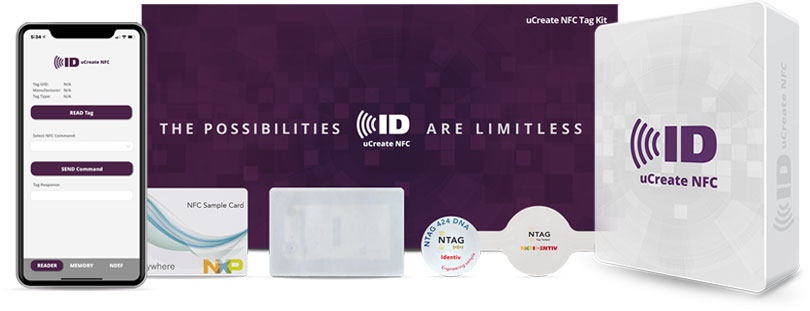RFID Journal: SDK Makes NFC App Designing Easier
October 4, 2021
Original article published by Claire Swedberg via
RFID Journal.

Identiv's uCreate software developers kit includes an app, sample tags and an education platform to help companies build Near Field Communication into their own apps.
Identiv wants to make Near Field Communication (NFC) technology use and development easier for those who build apps. While developers often have considerable knowledge and skill related to applications and software development, NFC technology—and how to build it into an app—largely remains an unknown. For this reason, the company has launched a software development kit (SDK) as part of its uCreate NFC offering. The uCreate platform comes with a selection of common tag types, software source code for programming and a mobile app.
Additionally, the company is organizing a developer community in which app developers can gain or share information. The community will connect RFID and NFC experts with beginners for the purpose of app development and prototype production support, according to Cathy Nguyen, Identiv's product marketing manager. The long-term goal, she says, is for Identiv to serve as a thought leader in NFC technology deployment, rather than just as a technology provider.
The global NFC and RFID transponder company for authentication and security solutions was formed in 2010 by employees from SCM Microsystems, Blue-Hill ID and Hirsch Electronics. Its customers include organizations in the government, enterprise, consumer, education, healthcare and transportation sectors. The company's uCreate NFC platform is intended to attract more developers into the NFC community, thereby encouraging additional use cases, says Vera Mauerberger, Identiv's product manager for RFID transponders.
"The idea behind uCreate," Mauerberger explains, "is to provide a tool for mobile app developers so they can get educated on how to work with NFC products and create NFC mobile apps."
The demand for NFC tags has been growing exponentially, the company has found, especially with the adoption of open NFC functionality that began with Apple's iOS13 in 2019. Systems being developed include everything from access control and ticketing to transportation payments and brand authentication. However, Identiv reports, there are not many tools available for app developers who aren't native to NFC technology.
While there are some NFC-enabling apps, most allow for simple applications, such as linking a tag read with a website; individuals would tap an NFC tag with their phone, which would then open a site. For instance, users might tap a product label to view the website of a brand that makes a particular product. The uCreate SDK, however, is designed to allow command writing beyond simply writing code for a URL on a tag's unique ID number. It also enables the coding of blocks within the tag memory for more detailed programming, Mauerberger explains.
UCreate NFC includes a kit containing four different types of tags that serve unique purposes—three of each kind—for users to test and trial with the specific applications being developed. These include a tamper-detection tag, a ticket-sized paper card Type 2 tag, a Type 5 library format label, and an NTAG 424 DNA cryptotag for advanced security. Such options are expected to change over time as technology and use cases evolve.
Typically, the company notes, Type-2 tags are lower in cost and are offered as read-write or read-only versions. Type-4, such as the DNA, can store more data and can include features like tamper detection and higher security. Type 5 tags, such as NXP's ICODE or STMicroelectronics' ST25TB families, comply with ISO 15693 and are relatively low in cost. Those that do not wish to purchase tags can download the SDK source code and the app to aid in NFC coding, Mauerberger says, though she adds, "The best solution is to use all the tools together," including the NFC tags.
The SDK is available now. Developers building their own applications can use the uCreate app to select the type of NFC functionality they wish to employ. They would scroll down the command window to select the necessary command to implement for a given tag type, then look up the associated code in the SDK and program their app to enable the reading and writing of specific messages to the tags. Users can access the source code at Identiv's website, as well as obtain the SDK source code and tags at the shop for $9.99. The app is also available for both iOS- and Android-based devices at no cost.
The RFID developer community is currently under construction, and it begins with key thought leaders, such as Identiv partners, who can share knowledge and advice. The community, which will roll out later this fall, is expected to provide reports, webinars, and question-and-answer formats for developers who require support. Conversations are now in the works regarding the details of what the community will provide and how it will be organized, Identiv indicates.
The goal is to provide a place where people can learn about NFC and RFID technologies, Mauerberger explains. "The idea is to trigger app developers to work with NFC," she says, "and to bring more NFC apps to the market," which would benefit Identiv and others in the NFC industry. "Once that happens, the demand grows, which is good for us, but it also makes it easier for our customers." Such customers include companies that purchase the tags and want to expand how they can be used.
As NFC use becomes more mainstream, Mauerberger reports, the diversity of solutions has been growing. According to
Allied Market Research, the COVID-19 pandemic has further accelerated the mobile payment industry, reducing the need for transactions with shared, touched surfaces, such as key pads and touch screens. In addition, NFC is being built into wearable items for fraud prevention, connected homes and contactless payments. Mauerberger says the options for NFC applications are limitless. "I'm impressed and surprised again and again [by] the new ideas," she states.